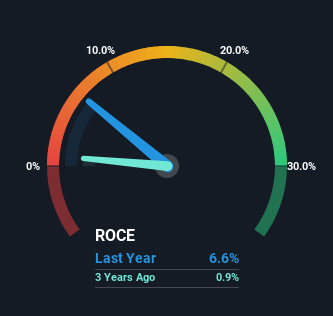- South Korea
- /
- Metals and Mining
- /
- KOSE:A008970
Returns On Capital Are Showing Encouraging Signs At Dong Yang Steel Pipe (KRX:008970)
If we want to find a potential multi-bagger, often there are underlying trends that can provide clues. Ideally, a business will show two trends; firstly a growing return on capital employed (ROCE) and secondly, an increasing amount of capital employed. Basically this means that a company has profitable initiatives that it can continue to reinvest in, which is a trait of a compounding machine. So on that note, Dong Yang Steel Pipe (KRX:008970) looks quite promising in regards to its trends of return on capital.
What Is Return On Capital Employed (ROCE)?
For those that aren't sure what ROCE is, it measures the amount of pre-tax profits a company can generate from the capital employed in its business. Analysts use this formula to calculate it for Dong Yang Steel Pipe:
Return on Capital Employed = Earnings Before Interest and Tax (EBIT) ÷ (Total Assets - Current Liabilities)
0.066 = ₩6.9b ÷ (₩198b - ₩94b) (Based on the trailing twelve months to June 2024).
Therefore, Dong Yang Steel Pipe has an ROCE of 6.6%. On its own that's a low return, but compared to the average of 5.2% generated by the Metals and Mining industry, it's much better.
See our latest analysis for Dong Yang Steel Pipe

While the past is not representative of the future, it can be helpful to know how a company has performed historically, which is why we have this chart above. If you want to delve into the historical earnings , check out these free graphs detailing revenue and cash flow performance of Dong Yang Steel Pipe.
So How Is Dong Yang Steel Pipe's ROCE Trending?
We're delighted to see that Dong Yang Steel Pipe is reaping rewards from its investments and is now generating some pre-tax profits. Shareholders would no doubt be pleased with this because the business was loss-making five years ago but is is now generating 6.6% on its capital. And unsurprisingly, like most companies trying to break into the black, Dong Yang Steel Pipe is utilizing 22% more capital than it was five years ago. We like this trend, because it tells us the company has profitable reinvestment opportunities available to it, and if it continues going forward that can lead to a multi-bagger performance.
On a separate but related note, it's important to know that Dong Yang Steel Pipe has a current liabilities to total assets ratio of 47%, which we'd consider pretty high. This can bring about some risks because the company is basically operating with a rather large reliance on its suppliers or other sorts of short-term creditors. Ideally we'd like to see this reduce as that would mean fewer obligations bearing risks.
What We Can Learn From Dong Yang Steel Pipe's ROCE
Long story short, we're delighted to see that Dong Yang Steel Pipe's reinvestment activities have paid off and the company is now profitable. And since the stock has fallen 34% over the last five years, there might be an opportunity here. With that in mind, we believe the promising trends warrant this stock for further investigation.
One more thing: We've identified 4 warning signs with Dong Yang Steel Pipe (at least 1 which can't be ignored) , and understanding them would certainly be useful.
While Dong Yang Steel Pipe isn't earning the highest return, check out this free list of companies that are earning high returns on equity with solid balance sheets.
Valuation is complex, but we're here to simplify it.
Discover if Kbi Dong Yang Steel PipeLtd might be undervalued or overvalued with our detailed analysis, featuring fair value estimates, potential risks, dividends, insider trades, and its financial condition.
Access Free AnalysisHave feedback on this article? Concerned about the content? Get in touch with us directly. Alternatively, email editorial-team (at) simplywallst.com.
This article by Simply Wall St is general in nature. We provide commentary based on historical data and analyst forecasts only using an unbiased methodology and our articles are not intended to be financial advice. It does not constitute a recommendation to buy or sell any stock, and does not take account of your objectives, or your financial situation. We aim to bring you long-term focused analysis driven by fundamental data. Note that our analysis may not factor in the latest price-sensitive company announcements or qualitative material. Simply Wall St has no position in any stocks mentioned.
About KOSE:A008970
Kbi Dong Yang Steel PipeLtd
Manufactures and sells steel pipes in South Korea, the United States, rest of Asia, Europe, the Middle East, and internationally.
Excellent balance sheet with very low risk.
Market Insights
Community Narratives



